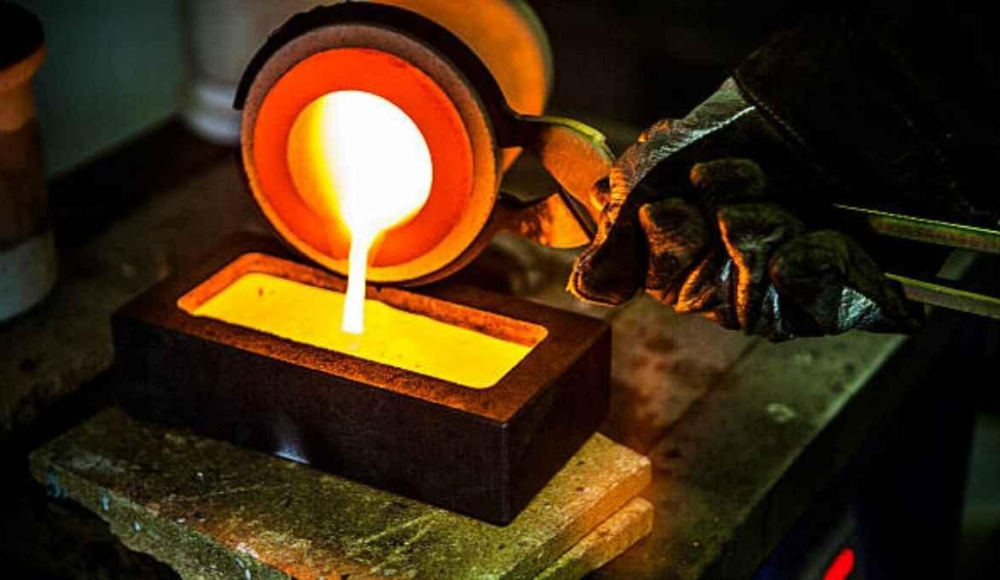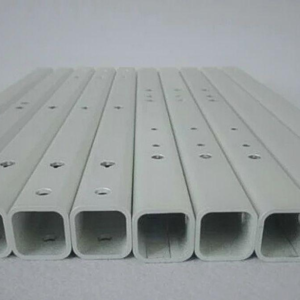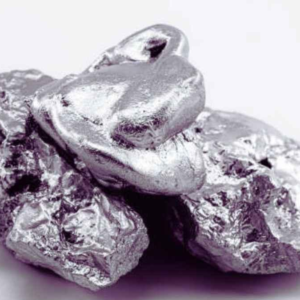金は宝飾品の製造や投資にとって優れた金属です. あなたがジュエリーメーカーなら, 金の溶解特性に注意する必要があります. さもないと, 高額な損失を被る可能性があります. 金の融点は実際の用途に影響を与えます. この温度を適切に見積もっていないと、不十分な製作または精製プロセスにつながります。.
このガイドでは、金の融点とその重要性に焦点を当てています。. この洞察をもとに, 金を作って投資する際に適切な決定を下すことができます.
金の融点とは?
ゴールドには「融点周りの 1064 摂氏度 (1947 華氏). 融点が高いため、ジュエリーやエレクトロニクスなど、さまざまな分野で役立ちます。, 例えば, 柔軟性や変形が許容できない場合.
金の融点に影響を与える要因
金が溶ける要因はいくつかあります。. これらの要素の知識はジュエリー製作において特に重要です, 冶金, およびエレクトロニクスアプリケーション.
1. 純度
金の割合は融点に影響します, 金属の純度に関係するので、. 純金(24 カラット) 融点は検証されていますが、金を 18K や 14K などの他の金属と混合すると、融点が異なります。.
2. 元素の合金化
銅, 銀, またはニッケル, 合金中に存在する, 合金の融点を上昇または低下させることができます. 例えば, 通常、銅を添加すると融点が高くなりますが、一部の金属を添加すると融点が下がります。.
3. 温度と圧力
融点などの主要な要素は、どの標準圧力でも変化しませんが、. それ;プレッシャーの影響を受けることが多い.
4. 粒子構造
金の粒子構造はその溶解特性に重要な役割を果たします. 細かい粒子は、粗い粒子よりも均一に溶ける可能性があります, 溶解時の熱のかかり方に影響を与える可能性があります.
5. 不純物
不純物の濃度がたとえ微量であっても、融点に影響を与える可能性があります。. 鉛やカドミウムなどの他の成分が存在する場合、金の溶解特性が何らかの形で変化します。.
金の融点を知ることが重要な理由?
金の溶解温度について知る理由はいくつかあります。:
1. ジュエリー作り
ジュエリー作りにおいて, 融点を意識することで、品質に影響を与えることなく金を溶かし、成形することができます。. このような詳細なレベルは、職人がより良い製品を開発することを奨励します。.
2. 金属精錬
精製業者は金の精製時の融点を知っておく必要があります. この知識により効率的な処理が可能になります. また、汚染物質を完全に除去し、より高い純度を実現します。.
3. 合金の生産
特に, 金の使用は他の金属と組み合わせる際の融点に依存します. これは、強度などの新しい合金の特性を制御するのに役立ちます, そして色.
4. 鋳造と成形
鋳造プロセスではシステム内の温度を厳密に制御する必要があります. それで, 融点を理解すると、不十分な融解や過熱などの問題を回避できます。.
5. エレクトロニクスおよび産業用途
高い導電性とゼロの腐食率により、多くの電子機器に使用されています。. 融点を知ることで、メーカーは品質に影響を与えることなくコンポーネントに適用することができます。.
6. 投資の決定
投資の選択は投資家が選択する分野によって異なります. しかし, 青銅の融点は、金の延べ棒や金貨に投資する際の品質を決定する上で非常に重要です。. 本物と偽物の金製品、または金で作られた製品を分類するために使用できます。.
金の溶解温度を他の金属と比較する方法
他の金属との関連における金の融点などの熱的特性は、研究において非常に重要です。. 金の融点をさまざまな一般的な金属と比較してみると次のようになります。:
金
- 融点: 約1,064℃ (1,947°F).
- 特徴: 剛性が低い、または性質上脆い, そのため、簡単に形を整えたり成形したりすることができます.
銀
- 融点: について 961 ℃ (1,762 °F).
- 比較: 銀の融点は金よりも低いため、鋳造や成形が容易です。.
銅
- 融点: それは周りにあります 1085 ℃ (1985 °F).
- 比較: 銅は金よりも融点が高いため、場合によっては加工が困難になります。.
アルミニウム
- 融点: その周り 660 ℃ (1,220 °F).
- 比較: アルミニウムは鋼よりも融点が非常に低いため、加工が容易です。, 製造を容易にする.
白金
- 融点: について 1,768 ℃ (3,214 °F).
- 比較: プラチナは金よりもはるかに高い融点を持っています, 高価な装置を使用して 2 つの金属を分離する必要がある.
鉄
- 融点: 約摂氏 1538 度または華氏 2800 度.
- 比較: 鉄の融点は比較的高い, 建設や機械における用途が変わります.
溶解温度と金グレードの関係
ゴールドはさまざまなグレードで提供されます, 純度や合金成分の違いにより、グレードごとに融点が異なります。. さまざまな金グレードの溶解温度の内訳は次のとおりです。:
24Kゴールド
- 純度: 99.9% 純金.
- 融点: 1040℃~1060℃程度 1900 °F.
- 特徴: 最高の品質, 投資やジュエリーの目的に適しています.
22Kゴールド
- 純度: 91.7% 純金.
- 融点: その周り 1,063 ℃ (1,945 °F).
- 特徴: 合金金属の導入による融点の低下; 高級宝飾品などに使われている.
18Kゴールド
- 純度: 75% 純金.
- 融点: 専攻したのは約 1,062 ℃ (1,944 °F).
- 特徴: 宝飾品によく使われる, 高い強度を兼ね備えています, 金含有量を抑えた美しさ.
14Kゴールド
- 純度: 58.3% 純金.
- 融点: について 1,060 ℃ (1,940 °F).
- 特徴: 適度な耐摩耗性を備え、安価なジュエリー製品に広く使用されています。.
10Kゴールド
- 純度: 41.7% 純金.
- 融点: について 1058 ℃ (1976 °F).
- 特徴: 金の濃度は最も低いですが、それでも他のタイプの金メッキ製品よりも安価で、ある程度の金の光沢があります。.
金を溶かす方法?
金の溶解には、危険を排除し最良の結果を得るために適切な準備と適切なツールが必要です. 金を溶かす方法についてのステップバイステップのガイドは次のとおりです。:
1. 必要な装備を集める
- 坩堝: 金を溶かす際に対応するオーブン.
- 熱源: 炉, そしてプロパントーチ(誘導加熱器) 必要な温度に達するために.
- 安全装置: 保護メガネの形をしたヘッドギア, 保護手袋, 熱や飛沫を防ぐための保護エプロン.
2. ゴールドを準備する
- ゴールドをきれいにする: きれいに溶けるように、金片から不要な材料を削り落とします。.
- みじん切りまたは細断: 大きなピースを溶かす場合は、みじん切りまたは細断してピースのサイズを小さくし、溶けやすくします。.
3. 作業領域をセットアップする
- 換気: 換気の良い場所であることを確認してください. それで, あらゆる煙の吸入による危害を避けることができます.
- 火災安全: 必ず消火器を近くに用意し、周囲に燃えやすいものを取り除いてください。.
4. るつぼを加熱する
- 予熱: 炉を使用する場合, くらいまで加熱する必要がある 1064 摂氏(金の融点).
- トーチの使用: プロパントーチの操作用, あらゆる角度から炎をるつぼに向けるようにしてください, 均一に加熱するために.
5. るつぼに金を加える
- ゴールドを慎重に配置する: るつぼが熱くなったら、飛び散りを防ぐために少量の金片をるつぼに入れます。.
- 溶ける様子を監視する: 金が液体の水たまりになるように注意してください。.
6. 溶けた金を注ぎます
- 型を使用する: 完全に溶けた後, あらかじめ形を整えた型に時間をかけて流し込みます.
- クールにしましょう: 金をコースティングし、冷却してモデルに固めます。.
7. 掃除
- 機器の清掃: プロセス後, 再度使用する場合は、他の材料との混合を避けるために、るつぼとツールを洗浄してください。.
- 安全に保管する: 溶かした金は将来使用できるように安全な場所に保管してください.
金の融点と沸点の比較方法
金が溶けるのは、 1,064 摂氏 (1,947 華氏度), 鋳造や精製の際に対処しやすくなります。. 対照的に, 沸点は約です 2,856 摂氏 (5,173 華氏度), したがって、金は蒸発するまで、幅広い温度範囲で液体状態を保ちます。. 沸点は融点のほぼ3倍です, これは、宝石商や製造業者が金が沸騰するリスクを負うことなく、金を溶かして加工できることを意味します。.
金の融点を下げる方法?
金の融点を下げる方法はいくつかあります。:
1. 他の金属との合金化
金の溶解温度の低下は、他の合金と併用することで可能になります。. 例えば:
- 銅: それは強度を高めますし、, 加えて, 銅は融点をわずかに下げます.
- 銀: 銀は融点も下げる, 合金の加工性を向上させます。.
2. 不純物の増加
少量の干渉物やその他の成分の混入によっても、金の溶解特性が変化する可能性があります。. しかし, この方法では、全体的な品質と金の純度が低下する可能性があります。.
3. フラックスの使用
溶解プロセス中にフラックスの助けを借りて溶解温度を下げることが可能です. フラックスは、精製プロセスによる不要な物質の除去を支援します。.
最終的なまとめ
金の融点とその制御可能な要素は、宝飾品業界などの用途におけるさまざまな目的にとって重要です。. したがって、合金化によって融点を制御する技術が開発されたことを知ることは心強いことです。, 不純物の添加, または、フラックスを使用してプロジェクトで望ましい結果を得ることが可能です. さらに遠く, 融点と沸点の重要性により、正しい方法で慎重に金を扱うことが保証されます.
トピックの詳細については、, 金の融点, 連絡を取る 精度の高いトップ. 私たちは信頼できるパートナーであり、ゴールドと連携する際に適切な情報を提供します。. ご質問がある場合、またはさらにサポートが必要な場合は, お気軽にお問い合わせください!




1 「」について考えました金の融点 – 完全なガイド”